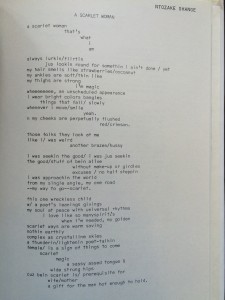Reading Zake: “A Scarlet Woman”
For the past few months, I have been going through the works of Third World Women and Peoples collectives from the 70s and this journey began with learning that Ntozake Shange contributed to the first anthology by Third World Women. Titled “Third World Women,” it was published by the collective, Third World Communications in 1972. The editors preface, “We recognize the necessity for Third World people to have accessible to them material written by and for them – we must be able to see, hear, feel, smell, taste portraits of ourselves”. With this mission in mind, Shange submits this poem, “A Scarlet Woman” to the anthology, and at first read, I loved it in the same ways that I loved her poem “We Need a God Who Bleeds Now” (A Daughter’s Geography).
“a scarlet woman
that’s
what
I
am”.
It reclaims this identity of the “scarlet woman” through claiming power in the feminine and calling attention to sexism. She identifies the feminine in how her “hair smells like strawberries/ cocoanut,” and how her “thighs are strong”. Additionally, the feminine is associated with a looseness, like how “bright color bangs” fall and shift in unplanned ways in response to the movement of the body. This looseness is in contrast to the rigidness of roles and expectations that come with the patriarchy and sexism. She says,
“I was seekin the good/ i was just seekin
the good/ stuff of bein alive
without make-up or girdles
excuses / no half steppin”
This poem speaks to me in the same ways that “We Need a God Who Bleeds Now” because it interprets power and love in quotidian womanly things and contrasts it with the harm and destruction of masculinity/ patriarchy. Both of these poems allude to the menses and locate femininity in bleeding scarlet and for this the poems are too troubling in the same ways.
The poem ends by concluding,
“cuz bein scarlet is/ prerequisite for
wife/mother
a gift for the man hot enough to hold.”
While Shange works to describe the multiple meanings and ways in which a woman could be described as “scarlet,” throughout the poem, the link between “being scarlet” and “wife/mother” guides me to think of menstruation first and foremost; menstruation as the prerequisite for wife/motherhood. In reading this, it seems too easy to collapse femininity and feminine roles with menstruation, which is troubling for describing the experiences of some trans folks. I definitely think there is space and ambiguity written into her poem that allow for a queer interpretation, but I am wondering if that is enough. For me, the poem was interesting and moving until the last three lines where it explicitly situates the scarlet woman in relation to their roles as wife/mother and further positioned as a gift to a man – the scarlet woman became more defined and less fluid again.
I want to bring this up in the gatherings I plan to host with other women of color and gender nonconforming people of color. In these spaces, we will be in dialogue with each other as well as the folks from the 70s through going through their archives. I want to ask, “Do we read queerness in their works, even though it is not explicit (not that queerness is many times definable)? How do we want to read these works and what do we want to receive from these words? How do we hope to talk about femininity, gender, power, love, etc.?”



Comments ( 10 )